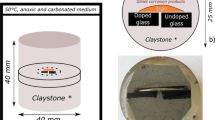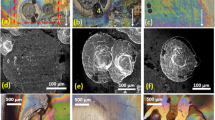Abstract
Previous work1 has shown that γ-radiation induced enhancement of leach rates from high-level radioactive waste (HLW) solids can be attributed to radiolytic acidification of the aqueous solution and to radiolytic formation of organic complexing species, for example, (COOH)2, HCOOH. Barkatt et al.1 compared the leach resistance of three HLW glasses and SYNROC D (specifically designed for incorporation of US defence wastes2) and found that, at low pH and with complexing agents, higher alumina contents in the waste form gave large enhancement of leach rates. Specifically, in acid solution, the elemental leach rates for SYNROC D were increased relative to the glasses by factors between 20 and 1,200. The formulation of SYNROC C, designed by Ringwood2 for incorporation of reprocessed waste from commercial power reactors, was not tested in these conditions. We report here that SYNROC C is considerably more resistant than the standard HLW glass PNL 76–68 to acid attack and to possible complexation reactions between 90 and 150 °C, despite an alumina content in the formulation that is much higher than that for PNL 76–68. The Al content of SYNROC C is much lower than that of SYNROC D (Table 1) and it is largely present in the hollandite phase after hot pressing. No aluminosilicate phases are formed in SYNROC C and, for this reason, the pH dependence is much less marked. These results are significant in assessing the effects of changes induced by the ionizing radiation to which the HLW solid and solution will be exposed during geological isolation.
This is a preview of subscription content, access via your institution
Access options
Subscribe to this journal
Receive 51 print issues and online access
$199.00 per year
only $3.90 per issue
Buy this article
- Purchase on Springer Link
- Instant access to full article PDF
Prices may be subject to local taxes which are calculated during checkout
Similar content being viewed by others
References
Barkatt, A., Barkatt, A. & Sousanpour, W. Nature 300, 339–341 (1982).
Ringwood, A. E. et al. Nucl. chem. Waste Manag. 2, 287–305 (1981).
Cousens, D. R. et al. Scientific Basis for Radioactive Waste Mangement Vol. 5 (ed. Lutze, W.) 310–317 (Elsevier, New York, 1982).
Campbell, J. et al. High Level Waste Technical Review, Atlanta (UCRL-85913, 1981).
Nuclear Waste Materials Handbook—Test Methods (DOE/ TIC-11400, Rev 1 Materials Characterization Center, Pacific Northwest Laboratory, 1983).
Reeve, K. D., Levins, D. M., Ramm, E. J. & Woolfrey, J. L. Proc. int. Symp. on Conditioning of Radioactive Wastes for Storage and Disposal, 375–390 (IAEA, Vienna, 1983).
Campbell, J. et al. Properties of SYNROC D Nuclear Waste Form: A State-of-the-Art Review (UCRL-53240, 1982).
Cooper, J. et al. The Incorporation and Retention of Caesium in SYNROC C (Griffith University).
Solomah, A. G. & Zumwalt, L. R. Nucl. chem. Waste Manag. 3, 111–115 (1982).
Dosch, R. G. & Lynch, A. E. Solution Chemistry in SYNROC Preparation (SAND 80-2375, 1980).
Strachan, D. M. Results from Long-term Use of the Static Leach Test Method (MCC-1) (PNL-SA-10762, 1982).
Author information
Authors and Affiliations
Rights and permissions
About this article
Cite this article
Levins, D., Smart, R. Effects of acidification and complexation from radiolytic reactions on leach rates of SYNROC C and nuclear waste glass. Nature 309, 776–778 (1984). https://doi.org/10.1038/309776a0
Received:
Accepted:
Issue Date:
DOI: https://doi.org/10.1038/309776a0
This article is cited by
Comments
By submitting a comment you agree to abide by our Terms and Community Guidelines. If you find something abusive or that does not comply with our terms or guidelines please flag it as inappropriate.



